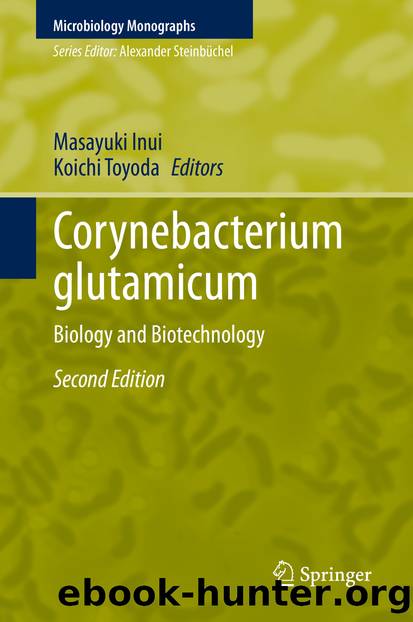Corynebacterium glutamicum by Unknown

Author:Unknown
Language: eng
Format: epub
ISBN: 9783030392673
Publisher: Springer International Publishing
Very recently, a different type of mechanosensitive channel was identified as a second glutamate exporter in some limited strains of C. glutamicum (Wang et al. 2018b). Although the channel MscCG2 shares only 23% identity with the NCgl1221 gene product, both channels have an important common feature: they need to be activated for glutamate production by the alteration of membrane tension, which is triggered by biotin limitation or penicillin treatment. This observation raises the question of how the new model may be congruent with the accepted notion that a decrease in the activity of the 2-oxoglutarate dehydrogenase complex (ODHC) is crucial for glutamate production (Shingu and Terui 1971; Kawahara et al. 1997; Kimura 2003; Asakura et al. 2007; Kim et al. 2009a, b). Although the new model seems to explain the basics of the mechanism underlying the induction of glutamate secretion, it is probably not sufficient to explain the entire process of glutamate production by C. glutamicum. Recently, a possible connection at a molecular level has been uncovered between ODHC activity and glutamate production (Fig. 11). A novel 15 kDa protein known as OdhI was identified as a regulator of ODHC (Niebisch et al. 2006). The unphosphorylated form of OdhI binds to the OdhA protein, one of the subunits of ODHC, and inhibits ODHC activity. This inhibition can be prevented by the PknG-catalyzed phosphorylation of OdhI. A phospho-serine/threonine protein phosphatase responsible for dephosphorylation of OdhI has also been identified (Schultz et al. 2007). Interestingly, disruption of the odhI gene was shown to abolish glutamate production even under the induction conditions (Schultz et al. 2007), suggesting a close relationship between the regulator protein and the reduction of ODHC activity that occurs during glutamate production. It is also worth noting that proteome analyses have revealed a significant increase in the OdhI protein upon penicillin treatment, which has become a conventional industrial method of triggering glutamate production (Kim et al. 2009a, b). These findings have confirmed the existence of a connection between ODHC activity and glutamate production, but it should be noted that an ODHC-activity-reducing metabolic change alone is not sufficient to induce glutamate production (Kim et al. 2009a, b).
Taken together, the evidence to date suggests a link between the induction treatments, such as biotin limitation and penicillin treatment, and glutamate production . In our proposed mechanism, the induction treatments enhance the synthesis of the regulator protein OdhI in its unphosphorylated form and thereby inhibit ODHC activity. This causes a metabolic shift at the branch point of 2-oxoglutarate, which channels carbon toward glutamate. Intracellularly-accumulated glutamate is then secreted into the medium via the NCgl1221 gene product YggB which has been activated in response to altered membrane tension (Fig. 11). Questions for the future include why and how the OdhI protein is overexpressed in response to the induction treatment and what conditions are required for the phosphorylation and dephosphorylation of OdhI.
Acetylome and succinylome analyses of glutamate-producing C. glutamicum have suggested that protein acetylation and succinylation are involved in glutamate production through the post-translational control of key enzymes such as phosphoenolpyruvate carboxylase (PPC) and ODHC (Mizuno et al.
Download
This site does not store any files on its server. We only index and link to content provided by other sites. Please contact the content providers to delete copyright contents if any and email us, we'll remove relevant links or contents immediately.
| Automotive | Engineering |
| Transportation |
Whiskies Galore by Ian Buxton(41879)
Introduction to Aircraft Design (Cambridge Aerospace Series) by John P. Fielding(33064)
Small Unmanned Fixed-wing Aircraft Design by Andrew J. Keane Andras Sobester James P. Scanlan & András Sóbester & James P. Scanlan(32743)
Craft Beer for the Homebrewer by Michael Agnew(18140)
Turbulence by E. J. Noyes(7936)
The Complete Stick Figure Physics Tutorials by Allen Sarah(7307)
Kaplan MCAT General Chemistry Review by Kaplan(6867)
The Thirst by Nesbo Jo(6826)
Bad Blood by John Carreyrou(6552)
Modelling of Convective Heat and Mass Transfer in Rotating Flows by Igor V. Shevchuk(6391)
Learning SQL by Alan Beaulieu(6211)
Weapons of Math Destruction by Cathy O'Neil(6144)
Man-made Catastrophes and Risk Information Concealment by Dmitry Chernov & Didier Sornette(5921)
Digital Minimalism by Cal Newport;(5664)
Life 3.0: Being Human in the Age of Artificial Intelligence by Tegmark Max(5474)
iGen by Jean M. Twenge(5366)
Secrets of Antigravity Propulsion: Tesla, UFOs, and Classified Aerospace Technology by Ph.D. Paul A. Laviolette(5309)
Design of Trajectory Optimization Approach for Space Maneuver Vehicle Skip Entry Problems by Runqi Chai & Al Savvaris & Antonios Tsourdos & Senchun Chai(5011)
Pale Blue Dot by Carl Sagan(4912)
